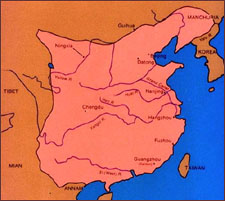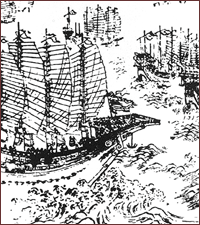 |
 |
|  As this striking animation shows,
China's 15th-century "treasure junks" would have dwarfed European
vessels of the time.
As this striking animation shows,
China's 15th-century "treasure junks" would have dwarfed European
vessels of the time.
View the clip in:
QuickTime | RealVideo:
dialup |
broadband
Get video software:
QuickTime |
RealVideo
|
Ancient Chinese Explorers
by Evan Hadingham
In 1999, New York Times journalist Nicholas D. Kristof reported a
surprising encounter on a tiny African island called Pate, just off the coast
of Kenya. Here, in a village of stone huts set amongst dense mangrove trees,
Kristof met a number of elderly men who told him that they were descendants of
Chinese sailors, shipwrecked on Pate many centuries ago. Their ancestors had
traded with the local Africans, who had given them giraffes to take back to
China; then their boat was driven onto the nearby reef. Kristof noted many
clues that seemed to confirm the islanders' tale, including their vaguely Asian
appearance and the presence of antique porcelain heirlooms in their
homes.
If Kristof's supposition is correct, then this remote African outpost retains
an echo of one of history's most astonishing episodes of maritime exploration.
Six centuries ago, a mighty armada of Chinese ships crossed the China Sea, then
ventured west to Ceylon, Arabia, and East Africa. The fleet consisted of giant
nine-masted junks, escorted by dozens of supply ships, water tankers,
transports for cavalry horses, and patrol boats. The armada's crew totaled more
than 27,000 sailors and soldiers. The largest of the junks were said to be over
400 feet long and 150 feet wide. (The Santa Maria, Columbus's largest
ship, was a mere 90 by 30 feet and his crew numbered only 90.)
Loaded with Chinese silk, porcelain, and lacquerware, the junks visited ports
around the Indian Ocean. Here, Arab and African merchants exchanged the spices,
ivory, medicines, rare woods, and pearls so eagerly sought by the Chinese
imperial court.
Seven times, from 1405 to 1433, the treasure fleets set off for the unknown.
These seven great expeditions brought a vast web of trading links—from
Taiwan to the Persian Gulf—under Chinese imperial control. This took place
half a century before the first Europeans, rounding the tip of Africa in frail
Portuguese caravels, 'discovered' the Indian Ocean.
 Despite the strength and prosperity that marked their empire, Ming
emperors deliberately chose not to try to colonize lands beyond the Middle
Kingdom.
Despite the strength and prosperity that marked their empire, Ming
emperors deliberately chose not to try to colonize lands beyond the Middle
Kingdom.
|
|
With unrivaled nautical technology and countless other inventions to their
credit, the Chinese were now poised to expand their influence beyond India and
Africa. Here was one of history's great turning points. Had the Chinese
emperors continued their huge investments in the treasure fleets, there is
little reason why they, rather than the Portuguese, Spanish, Dutch and British,
should not have colonized the world. Yet less than a century later, all
overseas trade was banned, and it became a capital offense to set sail from
China in a multi-masted ship. What explains this astonishing reversal of policy?
Roots of Chinese seapower
The first Chinese oceangoing trade ships were built far back in the Song dynasty
(c. 960-1270). But it was the subsequent Mongol emperors (the Yuan dynasty of
c. 1271-1368) who commissioned the first imperial treasure fleets and founded
trading posts in Sumatra, Ceylon, and southern India. When Marco Polo made his
famous journey to the Mongol court, he described four-masted junks with 60
individual cabins for merchants, watertight bulkheads, and crews of up to 300.
When the Han Chinese overthrew the Mongols and founded the Ming dynasty in the
later 14th century, they took over the fleet and an already extensive trade
network. The enterprising spirit of the Ming era reached a climax following the
rebellion of the warrior prince Zhu Di, who usurped the throne in 1402.
Disapproved of by the Confucian "establishment," Zhu Di put his trust in the
worldly eunuchs who had always sought their fortunes in commerce. During his
revolt, Zhu Di's right-hand man had been the Muslim eunuch Zheng He, whom he
now appointed to command the treasure fleet.
At the start of the first of Zheng He's epic voyages in 1403, it is said that
317 ships gathered in the port of Nanjing. As sociologist Janet Abu-Lughod
notes, "The impressive show of force that paraded around the Indian Ocean
during the first three decades of the 15th century was intended to signal the
'barbarian nations' that China had reassumed her rightful place in the
firmament of nations—had once again become the 'Middle Kingdom' of the
world."
|  Zheng He's
ships, as depicted in a Chinese woodblock print thought to date to the early
17th century.
Zheng He's
ships, as depicted in a Chinese woodblock print thought to date to the early
17th century.
|
Treasure junks: fact or fiction?
The Ming account of the voyages that followed strains credulity: "The ships which
sail the Southern Sea are like houses. When their sails are spread they are
like great clouds in the sky." Were the reported dimensions of the biggest
galleons—over 400 feet long by 150 wide—gross exaggerations? If accurate,
these dimensions would signal the biggest wooden ships ever built. Only the
mightiest wooden warships of the Victorian age approached these lengths, and
several of these vessels suffered from structural problems that required
extensive internal iron supports to hold the hull together. No such structures
are reported in the Chinese sources.
However, in 1962, the rudderpost of a treasure ship was excavated in the ruins
of one of the Ming boatyards in Nanjing. This timber was no less than 36 feet long.
Reverse engineering using the proportions typical of a traditional junk
indicated a hull length of around 500 feet.
Unfortunately, other archeological traces of this "golden age" of Chinese
seafaring remain elusive. One of the most intensively studied wrecks, found at
Quanzhou in 1973, dates from the earlier Song period; this substantial
double-masted ship probably sank sometime in the 1270's. Its V-shaped hull is
framed around a pine keel over 100 feet long and covered with a double layer of
intricately fitted cedar planking, thus clearly indicating its oceangoing
character. Inside, 13 compartments held the residue of an exotic cargo of
spices, shells, and fragrant woods, much of it originating in east Africa (see
Asia's Undersea Archeology).
The Quanzhou wreck suggests that over a century before Zheng He's fabled
voyages, the Chinese were already involved in ambitious trading exploits across
the Indian Ocean. Even back then, their sturdy ships equaled the largest known
European vessels of the period. By inventing watertight compartments and
efficient 'lugsails' that enabled them to steer close to the wind, Chinese
shipbuilders remained ahead of the west in the following centuries.
Continue: Exploits of the eunuch admiral
On China's China |
Ancient Chinese Explorers
Asia's Undersea Archeology |
Date the Dish |
Resources
Transcript |
Site Map |
Sultan's Lost Treasure Home
Editor's Picks |
Previous Sites |
Join Us/E-mail |
TV/Web Schedule |
About NOVA
Watch NOVAs online |
Teachers |
Site Map |
Shop |
Search |
To Print
PBS Online |
NOVA Online |
WGBH
© | Updated April 2003
|
|
|